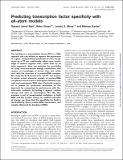Predicting transcription factor specificity with all-atom models
Author(s)
Virnau, Peter; Rahi, Sahand Jamal; Mirny, Leonid A.; Kardar, Mehran
DownloadRahi-2008-Predicting transcription factor specificity with all-atom models.pdf (466.6Kb)
PUBLISHER_CC
Publisher with Creative Commons License
Creative Commons Attribution
Terms of use
Metadata
Show full item recordAbstract
The binding of a transcription factor (TF) to a DNA operator site can initiate or repress the expression of a gene. Computational prediction of sites recognized by a TF has traditionally relied upon knowledge of several cognate sites, rather than an ab initio approach. Here, we examine the possibility of using structure-based energy calculations that require no knowledge of bound sites but rather start with the structure of a protein–DNA complex. We study the PurR Escherichia coli TF, and explore to which extent atomistic models of protein–DNA complexes can be used to distinguish between cognate and noncognate DNA sites. Particular emphasis is placed on systematic evaluation of this approach by comparing its performance with bioinformatic methods, by testing it against random decoys and sites of homologous TFs. We also examine a set of experimental mutations in both DNA and the protein. Using our explicit estimates of energy, we show that the specificity for PurR is dominated by direct protein–DNA interactions, and weakly influenced by bending of DNA.
Date issued
2008-10Department
Harvard University--MIT Division of Health Sciences and Technology; Massachusetts Institute of Technology. Department of PhysicsJournal
Nucleic Acids Research
Publisher
Oxford University Press (OUP)
Citation
Jamal Rahi, S. et al. “Predicting Transcription Factor Specificity with All-atom Models.” Nucleic Acids Research 36.19 (2008): 6209–6217. Web. 25 May 2012.
Version: Final published version
ISSN
0305-1048
1362-4962